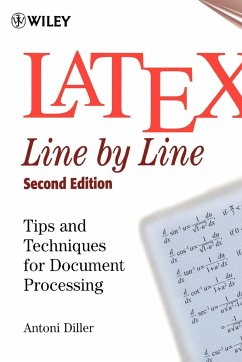Eine leicht verständliche Anleitung zum Umgang mit dem bekanntesten und meist verwendeten Textverarbeitungsprogramm in Wissenschaftskreisen. Erklärt werden Formatierungsgrundlagen sowie die etwas komplexeren Techniken für den Schriftsatz mathematischer Formeln. Geeignet ist das Lehrbuch sowohl für Neueinsteiger als auch für Nutzer der alten LATEX 2.09 Version. Dies ist eine vollständige und benutzerorientierte Einführung in das neue LATEX 2 mit neuem Material, einem Glossar zu allen LATEX 2 Basisbefehlen und einer Beschreibung der Hauptunterschiede zwischen dem alten LATEX 2.09 und der neuen Version. (02/99)
"...The book is nicely presented, with a useful set of goals at the beginning of each chapter. A good and comprehensive start towards creating a new and important sub-discipline...", , , Times Higher Educational Supplement, 17th September 1999 #"Full review: It does not need me to tell you that we are currently experiencing an explosion of information in an ever increasing number of formats - CD ROM, the Web, online databases and archives come immediately to mind. Moreover this information is found increasingly in a wide variety of different formats - not only text, but still an moving images, sound files and data held in spreadsheets. Hypermedia and the Web is a book which takes on the challenge of considering how to develop hypermedia processes based on sound engineering principles. Interactive information is approached as a structure that requires management, quantification and documentation. The authors describe the goal of the book as one of being a resource that can be used to improve the development of hypermedia data, to engender an awareness that successful development of hypermedia data requires a disciplined approach, and to demonstrate the possible future of this particular field over the next five years. It is divided into three parts. T he first - Hypermedia development fundamentals - gives a definition of hypermedia, describes how it can be modelled and engineered, and discusses how to obtain a quality product and process. The second section covers the development process, methods and techniques. The final section is devoted to research developments, such as research projects, Matilda, Microcosm (an open media system), the Amsterdam Hypermedia Model and Relationship Management Methodology for example. The intended readership of Hypermedia and the Web is anyone involved in the development of hypermedia products, be they application developers, application analysts, Web developers, and content and information experts. Both theoretical concerns and practical issues are dealt with, so it will appeal to anyone with an interest in either aspect. The book is not, however for the faint of heart nor for those with just a passing interest in the subject. It goes into considerable detail and makes valuable use of graphics in order to provide clarity w hen the going gets tough. Having said that, the reader is still faced with a densely packed book full of theory and practical analysis and, although it is written in a friendly and approachable style, it's not exactly the type of book you'd want to read on the beach. This shouldn't be seen as a criticism, since that isn't an intention of the author of course. Nevertheless it is a book that requires considerable concentration in order to get the most out of it. On the other hand, once you can get involved in the book the authors carry you along at a fair pace and make few assumptions, explaining in detail as they go and bringing in examples as needed to illustrate particular points. Indeed, they point out that a technical background is not necessary. I have my doubts as to whether or not Hypermedia and the Web would appeal to the majority of information professionals in their day-to-day work. However, if you have an active interest in the development of hypermedia and really want to get to grips with the subje ct you could do no better than get a hold of a copy. Furthermore, it should be within easy reaching distance of anyone who is producing anything other than the very basic Web pages or databases, and really should be a must in the personal library of anyone seriously developing databases and Websites which combine a variety of types of information in different formats.", Phil Bradley, Internet Consultant, Trainer, Web Designer & Author, #







